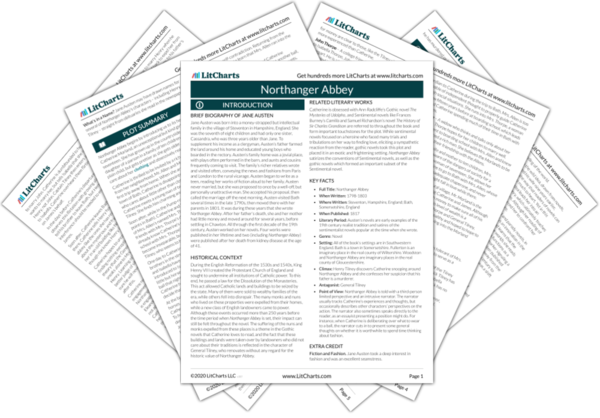Welcome to the LitCharts study guide on Jane Austen's Northanger Abbey. Created by the original team behind SparkNotes, LitCharts are the world's best literature guides.
Northanger Abbey: Introduction
A concise biography of Jane Austen plus historical and literary context for Northanger Abbey.
Northanger Abbey: Plot Summary
A quick-reference summary: Northanger Abbey on a single page.
Northanger Abbey: Detailed Summary & Analysis
In-depth summary and analysis of every chapter of Northanger Abbey. Visual theme-tracking, too.
Northanger Abbey: Themes
Explanations, analysis, and visualizations of Northanger Abbey's themes.
Northanger Abbey: Quotes
Northanger Abbey's important quotes, sortable by theme, character, or chapter.
Northanger Abbey: Characters
Description, analysis, and timelines for Northanger Abbey's characters.
Northanger Abbey: Symbols
Explanations of Northanger Abbey's symbols, and tracking of where they appear.
Northanger Abbey: Literary Devices
Northanger Abbey's key literary devices explained and sortable by chapter.
Northanger Abbey: Theme Wheel
An interactive data visualization of Northanger Abbey's plot and themes.
Brief Biography of Jane Austen
Jane Austen was born into a money-strapped but intellectual family in the village of Steventon in Hampshire, England. She was the seventh of eight children and had only one sister, Cassandra, who was three years older than Jane. To supplement his income as a clergyman, Austen’s father farmed the land around his home and educated young boys who boarded in the rectory. Austen’s family home was a jovial place, with plays often performed in the barn, and aunts and cousins frequently coming to visit. The family’s richer relatives wrote and visited often, conveying the news and fashions from Paris and London to the rural vicarage. Austen began to write as a teen, reading her works of fiction aloud to her family. Austen never married, but she was proposed to once by a well-off, but personally unattractive man. She accepted his proposal, then called the marriage off the next morning. Austen visited Bath several times in the late 1790s, then moved there with her parents in 1801. It was during these years that she wrote Northanger Abbey. After her father’s death, she and her mother had little money and moved around for several years, before settling in Chawton. All through the first decade of the 19th century, Austen worked on her novels. Four works were published in her lifetime and two (including Northanger Abbey) were published after her death from kidney disease at the age of 41.
Get the entire Northanger Abbey LitChart as a printable PDF.

Historical Context of Northanger Abbey
During the English Reformation of the 1530s and 1540s, King Henry VIII created the Protestant Church of England and sought to undermine all institutions of Catholic power. To this end, he passed a law for the Dissolution of the Monasteries. This act allowed Catholic lands and buildings to be seized by the state. Many of them were sold to wealthy families of the era, while others fell into disrepair. The many monks and nuns who lived on these properties were expelled from their homes, while a new class of English landowners came to power. Although these events occurred more than 250 years before the time period when Northanger Abbey is set, their impact can still be felt throughout the novel. The suffering of the nuns and monks expelled from these places is a theme in the Gothic novels that Catherine loves to read, and the fact that these buildings and lands were taken over by landowners who did not care about their traditions is reflected in the character of General Tilney, who renovates without any regard for the historic value of Northanger Abbey.
Other Books Related to Northanger Abbey
Catherine is obsessed with Ann Radcliffe’s Gothic novel The Mysteries of Udolpho, and Sentimental novels like Frances Burney’s Camilla and Samuel Richardson’s novel The History of Sir Charles Grandison are referred to throughout the book and form important touchstones for the plot. While sentimental novels focused on a heroine who faced many trials and tribulations on her way to finding love, eliciting a sympathetic reaction from the reader, gothic novels took this plot and placed it in an exotic and frightening setting. Northanger Abbey satirizes the conventions of Sentimental novels, as well as the gothic novels which formed an important subset of the Sentimental novel.
Key Facts about Northanger Abbey
- Full Title: Northanger Abbey
- When Written: 1798-1803
- Where Written: Steventon, Hampshire, England; Bath, Somersetshire, England
- When Published: 1817
- Literary Period: Austen’s novels are early examples of the 19th century realist tradition and satires of the sentimentalist novels popular at the time when she wrote.
- Genre: Novel
- Setting: All of the book’s settings are in Southwestern England. Bath is a town in Somersetshire. Fullerton is an imaginary place in the real county of Wiltershire. Woodston and Northanger Abbey are imaginary places in the real county of Gloucestershire.
- Climax: Henry Tilney discovers Catherine snooping around Northanger Abbey and she confesses her suspicion that his father is a murderer.
- Antagonist: General Tilney
- Point of View: Northanger Abbey is told with a third-person limited perspective and an intrusive narrator. The narrator usually tracks Catherine’s experiences and thoughts, but occasionally describes other characters’ perspectives on the action. The narrator also sometimes speaks directly to the reader, as an essayist presenting a position might do. For instance, when Catherine is deliberating over what to wear to a ball, the narrator cuts in to present some general thoughts on whether it is worthwhile to spend time thinking about fashion.
Extra Credit for Northanger Abbey
Fiction and Fashion. Jane Austen took a deep interest in fashion and was an excellent seamstress.
What’s in a Name? Jane Austen may have drawn names for several of Northanger Abbey’s characters – including Henry Tilney – straight from obituaries she read in the newspaper.












